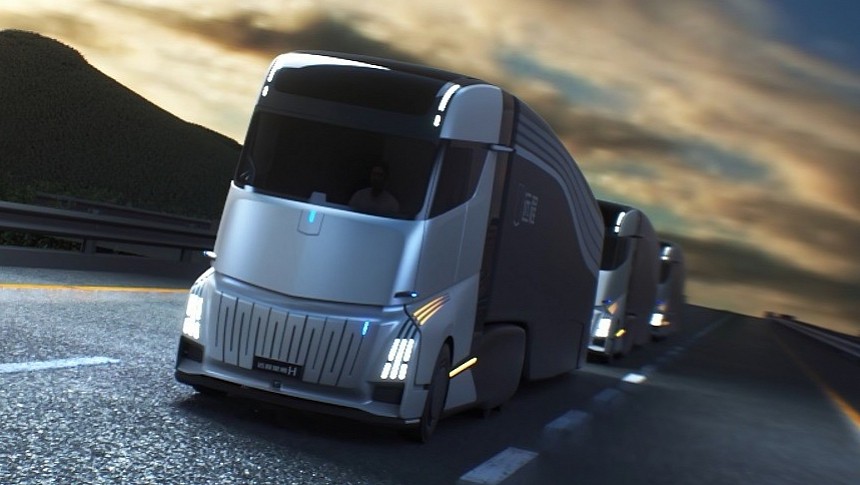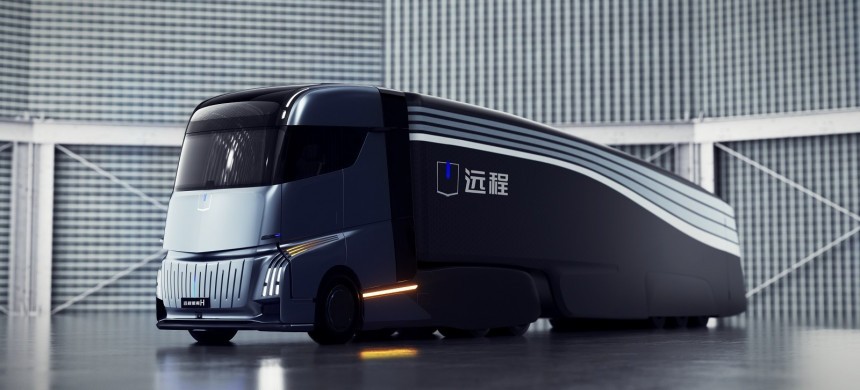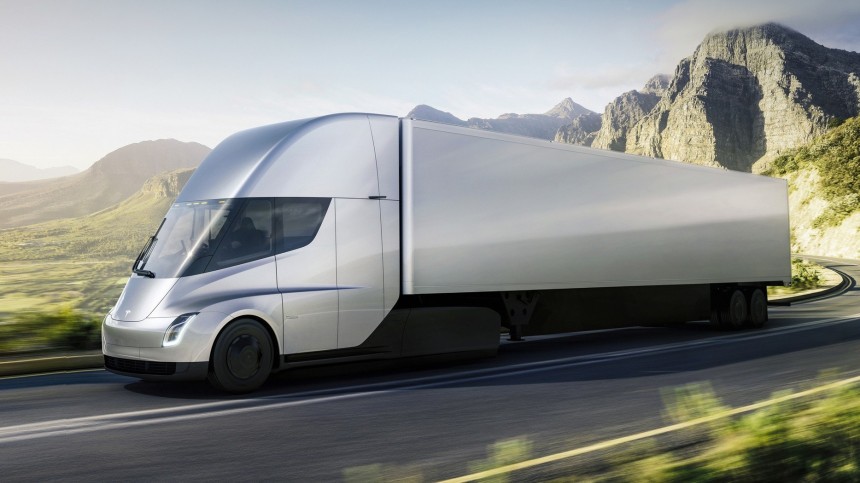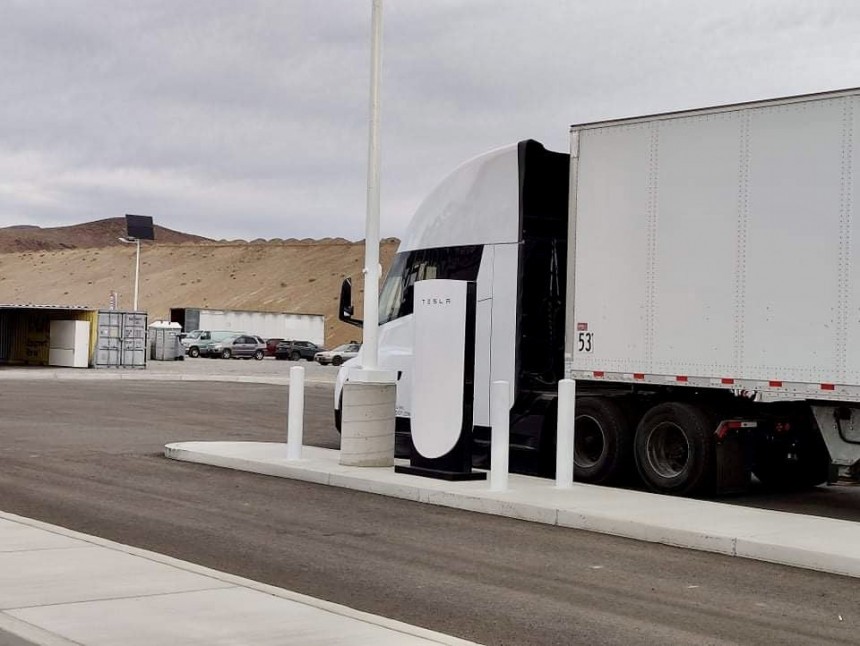A new regulation in Europe made me realize something that passed before my eyes in the past but did not receive the attention it deserved. In the US, Class 8 electric trucks can have a higher maximum gross weight than those powered by internal combustion engines (ICEs): instead of 80,000 pounds (36,287 kilograms), 82,000 lb (37,195 kg). The European Commission is studying the same measure, but is it fair?
Before anything else, it is crucial to analyze the reason for that weight difference: trucks powered by massive battery packs will have a lower load capacity compared to those with ICEs. After all, the components that allow them to move literally weigh tons. This is the most important contradiction involving battery electric trucks (BETs): it makes no sense for a transportation vehicle to waste its loading capacity dealing with its own mass. That means BETs have a major handicap right from the start compared to ICE trucks due to a maximum gross weight that should be the same for all cases. This is the fundamental requirement that new laws are subverting.
Trucks have a weight limit to preserve the roads. That is why governments have special scales on some highways: if these vehicles are heavier than they should be, their drivers will carry hefty fines back home. This also has significant safety implications: a truck that is heavier than it should be will not brake the way it should, which can lead to serious crashes. The safety concerns can be addressed by truck engineers, but roads that deteriorate more quickly than they were supposed to are another problem: a bigger one.
For a route to handle all the vehicles that will cross it every day, it must have been conceived and built for that. A local road having to deal with heavy trucks will present potholes or even more severe problems very quickly. To make matters more complicated, these roads are maintained in most countries with funds from fuel duty and similar taxes paid by those filling up their fuel tanks. For now, let's stick to the weight concern they pose.
In Europe, regulators have proposed the Greening Freight Package. Among its ideas is expanding the mass limit of heavy-duty vehicles (HDVs) from 40 metric tons (88,184.9 lb) to 44 metric tons (97,003.4 lb). That's 10% more than these vehicles used to weigh. Should the new regulation be approved, trucks may also be longer if they use body extensions to be more aerodynamic. Length limitations also exist for safety reasons: long trucks can be more challenging to steer on winding roads.
European legislators said allowing BETs to be heavier is a way to stimulate fleet owners to adopt "green" trucks. Apart from enabling them to carry the same amount of cargo as their ICE competitors, they may even enjoy an advantage in that regard should cell technology evolve. Should battery packs get lighter, these trucks may carry more cargo than their ICE competitors. On paper, that may look promising to anyone unaware of other aspects involving BETs. However, the main question here is: how do you justify the previous limit to ICE trucks? Why did they have to respect them and were even heavily fined for breaking them if a 10% increase is no big deal, as regulators claim? Take that a bit further: if this additional load capacity will not damage roads and highways, why can't ICE trucks also enjoy it right now?
We'll probably hear from these legislators that the idea is to curb carbon emissions, save the planet from global warming, etc. They may even argue that establishing goals and waiting for the best carbon-neutral solution to emerge would take too long. Under such premises, any excuse is apparently justifiable. Supposing you also do not buy that, is bending the rules to benefit the "chosen ones" the right way to achieve these goals, especially with so many other possible repercussions?
The most practical one is the damage that these heavier vehicles will cause to the road infrastructure. It may take years for that to happen, but there would be no limits if that were not a concern. When that happens, we will also face the question of who will pay to rebuild them. While ICE trucks are still allowed to drive, they will. When they are no longer running, legislators will probably come up with a new tax for electric trucks to pay – if they do not come up with it even earlier. However, this may be the least of their problems.
BETs will either have lower ranges than ICE trucks or pretty heavy battery packs to do a similar job. The additional weight limit may not prevent them from having a load disadvantage compared to their competitors running on fossil fuels. When these accumulators run out of juice, they will need fast charging to get back to work, which may be harmful to costs per mile in more than one way.
Although truck drivers in Europe are forced to stop for 45 minutes every four hours and a half, that may not be enough time to fast charge a humongous battery pack. Tesla claims its Supercharger V4 can deliver 1 MW of charging speed and that the Semi could recover 70% of charge in 30 minutes, but can it? Imagining that this is not a problem, fast charging is.
Just ask Tesla owners how much they pay to supercharge their cars, and you will probably hear people complaining about how expensive that is. Now imagine how much it will cost at much higher speeds: 1,000 kW (1 MW) instead of 250 kW. If the BEV maker charges less than it costs to fill up a diesel tank to charge a Semi, it will lose money. Independent charging networks will not have that liberty: they have to pay the bills and make a profit to expand.
If it gets more expensive to fast charge than to refuel an ICE truck, that will make the cost per mile in a BET higher than that in an ICE truck. However, BEV makers recommend that you only use fast charging every once in a while to preserve battery packs as much as possible. BETs will use that process all the time: a truck that does not run does not make money. That is why some fleet owners have several drivers for a single vehicle: to keep them running 24/7. On top of that, a massive battery pack would take days to charge slowly. BETs have no other option than fast charging, which will make their battery packs last less than they do in passenger vehicles. How much will it cost to replace them?
In the end, BETs are more expensive and demand more time to be ready to drive again when their energy is low. As I mentioned before, replacing their battery packs when these components are toast will cost a fortune. The resulting cost per mile will be very high unless regulators offer massive incentives for their purchase and fast charging. The inevitable conclusion is that governments will have to indefinitely cheat on more than just the maximum gross weight to make them minimally more competitive. When taxpayers' money ends – and regulators "decide" they can no longer interfere – the higher transportation costs will make everything get more expensive. Anyone willing to stop this disastrous chain reaction should voice their concerns right now. It would not be the first time alleged good intentions led to nasty outcomes.
Trucks have a weight limit to preserve the roads. That is why governments have special scales on some highways: if these vehicles are heavier than they should be, their drivers will carry hefty fines back home. This also has significant safety implications: a truck that is heavier than it should be will not brake the way it should, which can lead to serious crashes. The safety concerns can be addressed by truck engineers, but roads that deteriorate more quickly than they were supposed to are another problem: a bigger one.
For a route to handle all the vehicles that will cross it every day, it must have been conceived and built for that. A local road having to deal with heavy trucks will present potholes or even more severe problems very quickly. To make matters more complicated, these roads are maintained in most countries with funds from fuel duty and similar taxes paid by those filling up their fuel tanks. For now, let's stick to the weight concern they pose.
European legislators said allowing BETs to be heavier is a way to stimulate fleet owners to adopt "green" trucks. Apart from enabling them to carry the same amount of cargo as their ICE competitors, they may even enjoy an advantage in that regard should cell technology evolve. Should battery packs get lighter, these trucks may carry more cargo than their ICE competitors. On paper, that may look promising to anyone unaware of other aspects involving BETs. However, the main question here is: how do you justify the previous limit to ICE trucks? Why did they have to respect them and were even heavily fined for breaking them if a 10% increase is no big deal, as regulators claim? Take that a bit further: if this additional load capacity will not damage roads and highways, why can't ICE trucks also enjoy it right now?
We'll probably hear from these legislators that the idea is to curb carbon emissions, save the planet from global warming, etc. They may even argue that establishing goals and waiting for the best carbon-neutral solution to emerge would take too long. Under such premises, any excuse is apparently justifiable. Supposing you also do not buy that, is bending the rules to benefit the "chosen ones" the right way to achieve these goals, especially with so many other possible repercussions?
BETs will either have lower ranges than ICE trucks or pretty heavy battery packs to do a similar job. The additional weight limit may not prevent them from having a load disadvantage compared to their competitors running on fossil fuels. When these accumulators run out of juice, they will need fast charging to get back to work, which may be harmful to costs per mile in more than one way.
Although truck drivers in Europe are forced to stop for 45 minutes every four hours and a half, that may not be enough time to fast charge a humongous battery pack. Tesla claims its Supercharger V4 can deliver 1 MW of charging speed and that the Semi could recover 70% of charge in 30 minutes, but can it? Imagining that this is not a problem, fast charging is.
If it gets more expensive to fast charge than to refuel an ICE truck, that will make the cost per mile in a BET higher than that in an ICE truck. However, BEV makers recommend that you only use fast charging every once in a while to preserve battery packs as much as possible. BETs will use that process all the time: a truck that does not run does not make money. That is why some fleet owners have several drivers for a single vehicle: to keep them running 24/7. On top of that, a massive battery pack would take days to charge slowly. BETs have no other option than fast charging, which will make their battery packs last less than they do in passenger vehicles. How much will it cost to replace them?
In the end, BETs are more expensive and demand more time to be ready to drive again when their energy is low. As I mentioned before, replacing their battery packs when these components are toast will cost a fortune. The resulting cost per mile will be very high unless regulators offer massive incentives for their purchase and fast charging. The inevitable conclusion is that governments will have to indefinitely cheat on more than just the maximum gross weight to make them minimally more competitive. When taxpayers' money ends – and regulators "decide" they can no longer interfere – the higher transportation costs will make everything get more expensive. Anyone willing to stop this disastrous chain reaction should voice their concerns right now. It would not be the first time alleged good intentions led to nasty outcomes.


























































